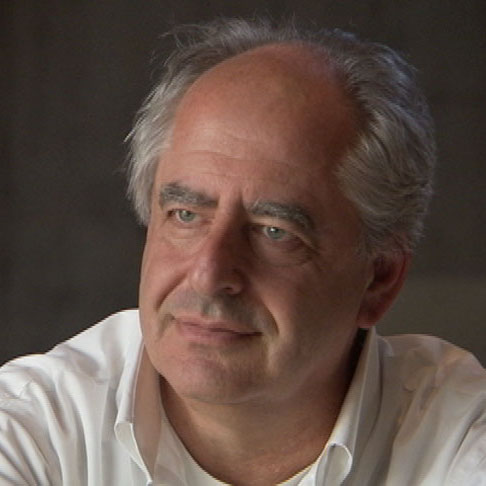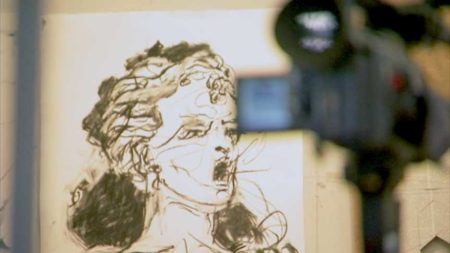Continue playing
(Time remaining: )
Play from beginning
Continue playing "{{ controller.videos[controller.getVideo(controller.currentVideo)].segmentParentTitle}}"
{{controller.videos[controller.getVideo(controller.currentVideo)].title}} has ended.
William Kentridge in "Compassion"
William Kentridge asks “how does one find a way of not necessarily illustrating the society that one lives in, but allowing what happens there to be part of the work?” Shooting without a script when making his animations, Kentridge’s experimental method demonstrates “thinking with one’s hands” and proposes an “understanding of the world as process rather than as fact.”
Filmed working in his Johannesburg studio with an opera singer and pianist, the artist is shown creating a video projection out of torn paper choreographed to a Puccini aria recorded through a cell phone. The segment follows Kentridge’s interest in opera as he stages a video installation and performance at the Sydney Biennial in Australia. The segment also showcases a series of anamorphic films projected onto circular tabletops, with a mirrored cylinder at the center that reconstitutes the distorted image.
More information and creditsCredits
Created by: Susan Sollins & Susan Dowling. Executive Producer & Curator: Susan Sollins. Series Producer: Eve-Laure Moros Ortega. Associate Producer: Migs Wright. Associate Curator: Wesley Miller. Production Manager: Nick Ravich. Production Coordinator: Larissa Nikola-Lisa. Consulting Director: Catherine Tatge. Editor: Mark Sutton. Director of Photography: Philippe Charluet, Bob Elfstrom, & Joel Shapiro. Additional Photography: Miguel Sanchez-Martin & Ross Sebek. Sound: Ray Day, Henri Maïkoff, Cory Melious, Evan McIntosh, Patrick Mullins, & Roger Phenix. Assistant Camera: Gregory Paul Bigelow, Craig Feldman, Agnès Jammal, & Clair Popkin. Production Assistant: Ivan Andres Aguirre, Jimmy Chauke, & Amira Abultaif Kadamani.
Creative Consultant: Ed Sherin. Art Direction & Design: Open, New York. Graphics Animation: Maurice Caicedo & Urosh Perishic. On-Line Editor: Don Wyllie. Composer: Peter Foley. Voice-Over Artist: Jace Alexander. Sound Editing: Margaret Crimmins & Greg Smith. Sound Mix: Cory Melious. Artwork Animation: Frank Ferrigno. Assistant Editor: Ahmed Amer, Janine Cappadona, Paulo Padilha, Joaquin Perez, Leana Siochi, & Ken Yapelli.
On Screen Participants (in order of appearance): Nokrismesi “Kimmy” Skota, Philip Miller, Sabine Theunissen, Catherine Meyburgh, Gyun Hur, Ashley Vieira, Carlos Andres Granada, Ramón Villamarin, Joaquin Sanabria, & Sergio Clavijo.
Artworks Courtesy of: William Kentridge; Doris Salcedo; Carrie Mae Weems; Alexander and Bonin, New York; Jack Shainman Gallery, New York; Marian Goodman Gallery, New York and Paris; & P·P·O·W, New York. Archival Footage & Photography Courtesy of: Anna Halprin Papers, Museum of Performance and Design, San Francisco; Connie Beeson; San Francisco Museum of Modern Art; & Tate Media, London.
Special Thanks: ACA Gallery, SCAD-Atlanta; Alfonso Amaya; Annandale Galleries, Sydney; The Art21 Board of Trustees; Michael Ashburn; Catherine Belloy; Jane Burton; The Biennale of Sydney; Travis Call; Daniel Cantoni; Wbaldo Castano; Pat Casteel and Steve Wylie; Dario Cardenas Chona; Ralph Cuccurullo; Natalie Dembo; Dog Bark Sound; Doris Salcedo Studio, Bogota; Laurie Ann Farrell; Frame:Runner, NYC; Erica Gangsei; The Hotel Syracuse; Jennifer M. Jones; The Kentridge family; Amy Legin; Linda Leibowitz; Amy Levin; Vanessa Lopez; Sheila Lynch; Maria Pia Mazzilli; Anne McIlleron; Luis Daniel Panqueva Medina; Brooke Mellen; Willian Camilo Ahumada Moscoso; National Black Arts Festival; Oliver Newton; David Perlman; Kyle Petersen; Ariel Phillips; Katie Rashid; Andre Ribuoli; Ancizar Rincón; Jared Schiller; Susan Schneider; Baraka Sele; Keith Shapiro; Sound Lounge; The Sydney Harbour Federation Trust; Pamela Vander Zwan; Tony Volante; & The Woodruff Arts Center.
Additional Art21 Staff: Beth Allen, Mary Cook, Joe Fusaro, Jessica Hamlin, Jennifer H. Lee, Marc Mayer, Jonathan Munar, Katherine Payne, Kelly Shindler, & Sara Simonson.
Interns: Maggie Bordonaro, Krystle DeMauro, Natalia P. Good, Sophie Grant, Pinchang Huang, Joy Lai, Rachele Lam, Jamie Leonardi, Melanie K. Mambo, Pauli Ochi, Sara Odam, David Roesing, Nicole Ross, Nicole Sansone, & Julia Wright.
Public Relations: Goodman Media International. Station Relations: De Shields Associates, Inc. Legal Counsel: Albert Gottesman. Bookkeeper: Valerie Riley. Travel Agent: Lita Gottesman.
Major underwriting for Art in the Twenty-First Century Season Five provided by: National Endowment for the Arts; Public Broadcasting Service; Agnes Gund; Bloomberg; The Nathan Cummings Foundation; The Andy Warhol Foundation for the Visual Arts; The Broad Art Foundation; Korea Foundation; & The Horace W. Goldsmith Foundation.
Closed captionsAvailable in English, German, Romanian, Italian, Japanese, Korean, Chinese, Italian
Through the Art21 Translation Project, multilingual audiences from around the globe can contribute translations, making Art21 films more accessible worldwide. Translate this video now.
Interested in showing this film in an exhibition or public screening? To license this video please visit Licensing & Reproduction.
Having witnessed first-hand one of the twentieth century’s most contentious struggles—the dissolution of apartheid—William Kentridge brings the ambiguity and subtlety of personal experience to public subjects that are most often framed in narrowly defined terms. Using film, drawing, sculpture, animation, and performance, he transmutes sobering political events into powerful poetic allegories. In a now-signature technique, Kentridge photographs his charcoal drawings and paper collages over time, recording scenes as they evolve.
“How does one find a way of, not necessarily illustrating the society that one lives in, but allowing what happens there to be part of the work, part of the vocabulary, part of the raw material that is dealt with?”
William Kentridge
William Kentridge
William Kentridge
William Kentridge




